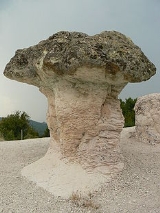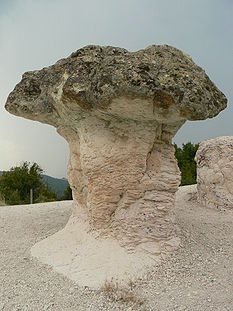
Mushroom stones
Encyclopedia

Limestone
Limestone is a sedimentary rock composed largely of the minerals calcite and aragonite, which are different crystal forms of calcium carbonate . Many limestones are composed from skeletal fragments of marine organisms such as coral or foraminifera....
boulders undercut by water. These take the form of solitary sentinels of limestone which still bear the unmistakable marks of long-continued erosion
Erosion
Erosion is when materials are removed from the surface and changed into something else. It only works by hydraulic actions and transport of solids in the natural environment, and leads to the deposition of these materials elsewhere...
by lapping waves at the edge of lakes which have since vanished or retreated. These stone sentinels are sometimes shaped like mushroom
Mushroom
A mushroom is the fleshy, spore-bearing fruiting body of a fungus, typically produced above ground on soil or on its food source. The standard for the name "mushroom" is the cultivated white button mushroom, Agaricus bisporus; hence the word "mushroom" is most often applied to those fungi that...
s; others have an overhang facing in just one direction, but all are notched and undercut in such a fashion as to suggest prolonged exposure to standing water at some time in the past. The mushroom-shaped stones are produced where the notching forms a fairly even circle around the stone. The wavestones in Ireland are always of limestone
Limestone
Limestone is a sedimentary rock composed largely of the minerals calcite and aragonite, which are different crystal forms of calcium carbonate . Many limestones are composed from skeletal fragments of marine organisms such as coral or foraminifera....
: generally isolated boulders which are often glacial erratic
Glacial erratic
A glacial erratic is a piece of rock that differs from the size and type of rock native to the area in which it rests. "Erratics" take their name from the Latin word errare, and are carried by glacial ice, often over distances of hundreds of kilometres...
s, or (much more rarely) exposed outcrop.
In Ireland
Ireland
Ireland is an island to the northwest of continental Europe. It is the third-largest island in Europe and the twentieth-largest island on Earth...
, wave stones were first recorded in 1865 by F.J. Foot along the shores of Lough Ree
Lough Ree
Lough Ree is a lake in the midlands of Ireland, the second of the three major lakes on the River Shannon. Lough Ree is the second largest lake on the Shannon after Lough Derg. The other two major lakes are Lough Allen to the north, and Lough Derg to the south, there are also several minor lakes...
, during the course of field work for the first systematic geological survey of Ireland. He made a drawing of these water-worn limestone blocks ‘eroded up to a certain height by the solvent action of former lake water, showing the level at which Lough Ree once stood – 10 to 15 feet higher than the present summer height: the lake shore, moreover, is now some 300 yards distant.’
Not all mushroom stones are situated close to modern lakes. Many mark the shores of lakes which have vanished altogether, becoming filled in with reedswamp, fen
Fen
A fen is a type of wetland fed by mineral-rich surface water or groundwater. Fens are characterised by their water chemistry, which is neutral or alkaline, with relatively high dissolved mineral levels but few other plant nutrients...
and bog
Bog
A bog, quagmire or mire is a wetland that accumulates acidic peat, a deposit of dead plant material—often mosses or, in Arctic climates, lichens....
vegetation in the course of time. A remarkable example is located near Crancreagh Bridge in County Offaly, which marks the position of what must have been the north-western edge of ancient Lough Boora, on whose shores the first people of the Irish midlands camped in Mesolithic
Mesolithic
The Mesolithic is an archaeological concept used to refer to certain groups of archaeological cultures defined as falling between the Paleolithic and the Neolithic....
times 8,500 or so years ago. This ancient lake disappeared long ago, swamped by the growing expanse of bog, which buried not only the lake itself, but preserved the campsites of the early midlanders.
To date, wavestones have been recorded in Counties Offaly, Tipperary, Galway, Clare, Cork, Roscommon and Westmeath.
Limestone
Limestone
Limestone is a sedimentary rock composed largely of the minerals calcite and aragonite, which are different crystal forms of calcium carbonate . Many limestones are composed from skeletal fragments of marine organisms such as coral or foraminifera....
accounts for nearly half of the framework of which the land of Ireland is made. Where it breaks through the envelope of soil and other materials which usually cover the rock beneath, it forms some of the most dramatic landscapes in the country. There are very few parts of Ireland where limestone so dominates the landscape as in the baronies of Burren
Burren
Burren can refer to:*The Burren, a karst landscape in County Clare, Ireland*Burren, County Down, a village in Northern Ireland*Burren College of Art, an art college in Ballyvaughan, County Clare, Ireland*Burrén and Burrena, twin hills in Aragon, Spain...
in Clare and Kiltartan in Galway
Galway
Galway or City of Galway is a city in County Galway, Republic of Ireland. It is the sixth largest and the fastest-growing city in Ireland. It is also the third largest city within the Republic and the only city in the Province of Connacht. Located on the west coast of Ireland, it sits on the...
. Here the grey limestone attains a thickness of 780 metres, exposed over an area of more than 250 square kilometres.
The story of the limestone begins about 350 million years ago, at the very end of the Devonian
Devonian
The Devonian is a geologic period and system of the Paleozoic Era spanning from the end of the Silurian Period, about 416.0 ± 2.8 Mya , to the beginning of the Carboniferous Period, about 359.2 ± 2.5 Mya...
period of earth history, when Ireland was still part of the Old Red Sandstone continent. At around this time the sea - which up to this had lain to the south - began to advance northwards over Ireland, ushering in the Lower Carboniferous period of earth history. A thick sequence of lime-rich (carbonate) sediments was deposited in the warm, shallow sea as the millennia passed. This thick blanket of sediment was later compacted and hardened to become limestone rock.
Where a limestone boulder stands at the edge of a lake so that it is partly covered by water, the underwater part weathers more rapidly then the part above water because it is subject to more constant corrosion by water, accentuated by the abrasive lapping action of waves. If this continues for a long time the upper part will be undercut, and the stone will assume a very distinctive form which is frequently mushroom-like. Much more rarely the same process can be seen in limestone bedrock. Many mushroom stones have a second minor ‘lip’ below the main one, suggesting that the drop in water level which isolated the stones from the lake’s edge took place in two stages.

